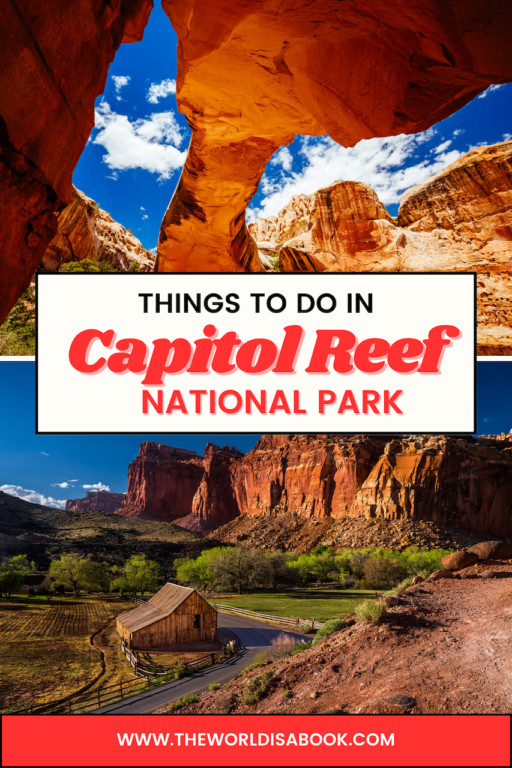Nestled deep within Utah’s rugged landscapes lies a hidden gem waiting to be explored. This truly is an underrated park. This was how to spend two days and things to do in Capitol Reef National Park.
We waited a long time to visit our last park of Utah’s “Mighty Five” National Parks. But, we finally made it after dropping off our son to college and starting our empty nester life. Our short and sweet visit was filled with hiking, fruit picking, learning history and exploring beautiful landscapes.
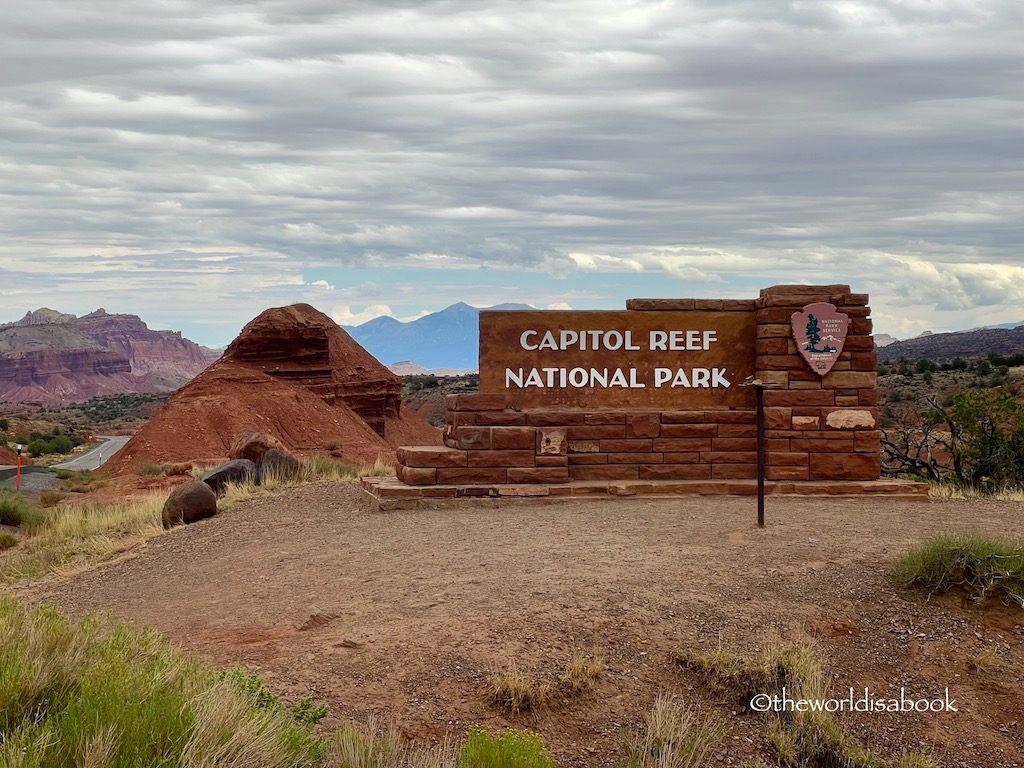
Getting There
Getting to Capitol Reef is actually easier than some other national parks we’ve visited. Located in south-central Utah, this park is a bit off the beaten path compared to some of its more famous neighbors like Zion and Bryce Canyon.
The nearest major airport is in Salt Lake City, about a 3.5-hour drive away. It was an easy and scenic drive though. Alternatively, you can fly into Grand Junction, Colorado, or Las Vegas, Nevada, each about a 4-hour drive to the park.
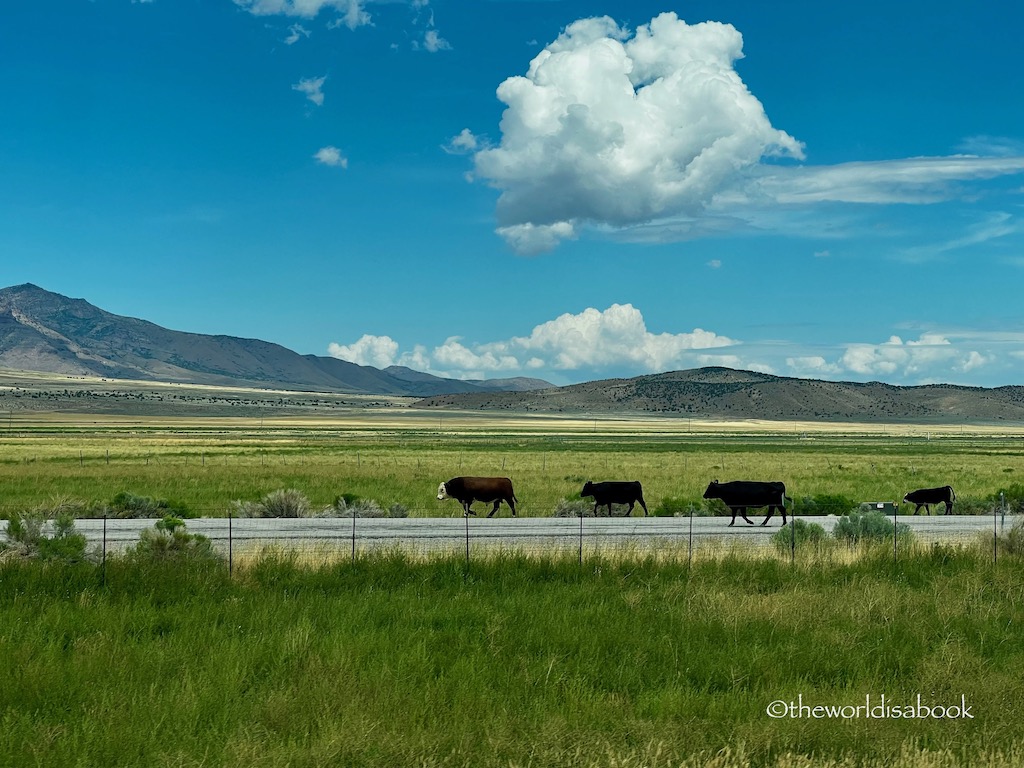
Capitol Reef History
To truly appreciate the beauty and significance of Capitol Reef National Park, it’s important to delve into its captivating history, which is as colorful as the rock formations that define the landscape.
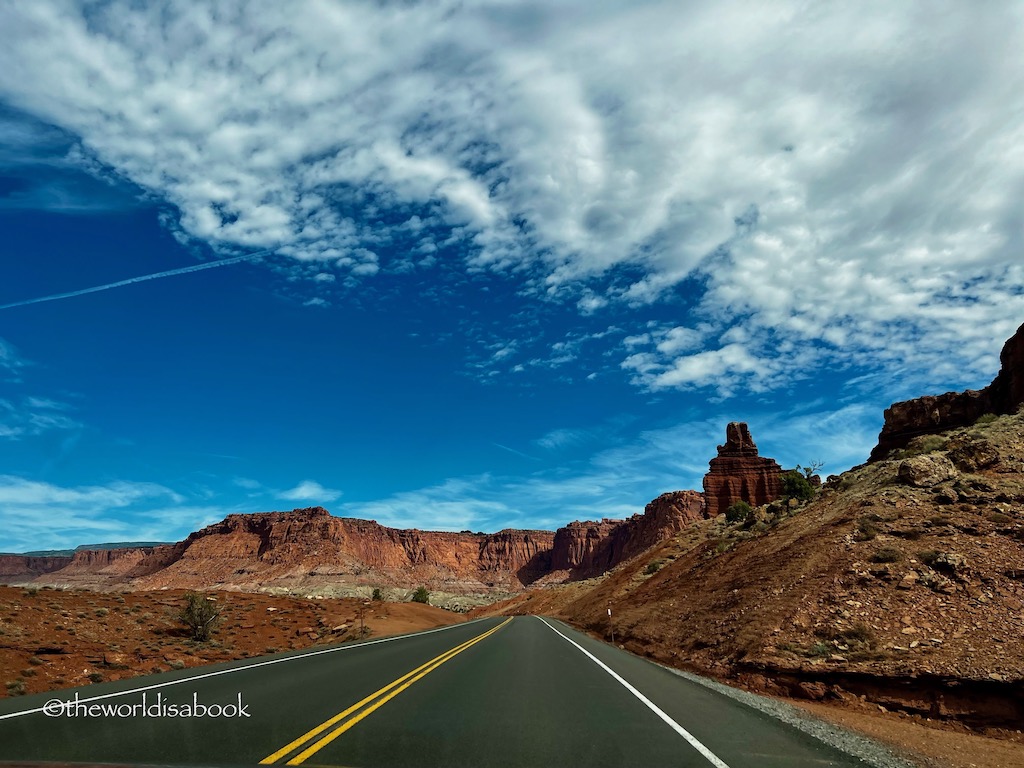
Why is it called Capitol Reef?
The unique name “Capitol Reef” can be traced back to early European American explorers. In the late 19th century, a group of settlers known as the “Wheeler Survey” explored the area.
When they encountered the towering, impassable Waterpocket Fold that runs through the heart of the park, they though it looked like a barrier reef in the ocean. But, it was a reef of impassable cliffs instead of water.
The impressive Capitol Dome on State Route 64 reminded the early travelers of the United States Capitol building and later inspired the name when it became a national park in 1950.
Things to do in Capitol Reef National Park
The park’s unique landscape is a playground for adventure seekers and nature lovers of all ages. Here are some must-do activities and attractions, including those suitable for kids:
Start at the Visitor’s Center
We always start our National Park visits at the Visitor’s Center. The park rangers are a wealth of information and will answer all your questions like which orchards are open, easiest hikes, what to do during your timeframe and know the road closures.
If you are traveling with kids, don’t forget to get the Junior Ranger packets. My kids really enjoyed doing these packets and earning their badges when they were younger. I learned quite a bit from these packets too.
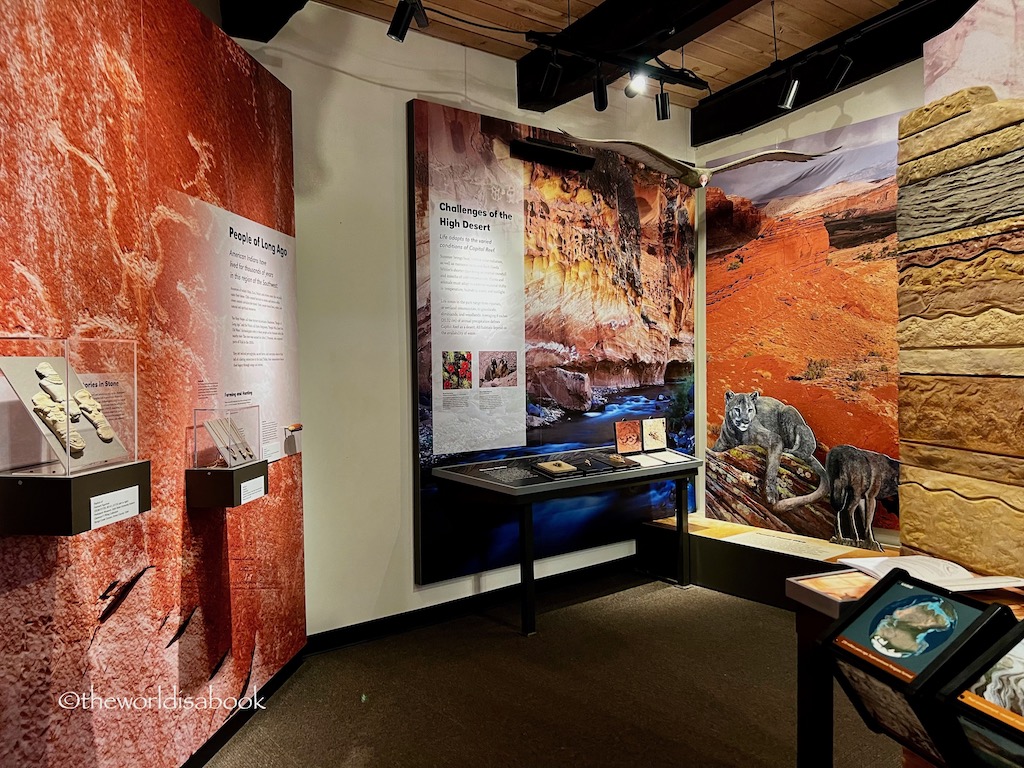
This visitor’s center was a bit smaller with some exhibits and a small store. Visitors can learn more about the park through the various exhibits and by watching the park movie.
Don’t forget to buy some souvenirs from your visit since all proceeds help support the park operations. The center is open everyday from 8AM – 4:30 PM with extended summer hours.
Visit the Fruita Historic District
One of the most intriguing chapters in Capitol Reef’s history revolves around the Mormon pioneers who settled in the area, particularly in an area now known as Fruita. In the late 19th century, Mormons began to establish communities throughout Utah, and the fertile lands along the Fremont River in what is now Capitol Reef beckoned to them.
In the early 1880s, a small group of Mormon families led by Nels Johnson ventured into the rugged canyons of the Waterpocket Fold and established the Fruita settlement. Their goal was to farm the fertile soil of the Fremont River valley as a cash crop and to live on.
Fruit trees, orchards, and crops flourished in Fruita, thanks to a well-engineered irrigation system that tapped into the Fremont River. Apricots, apples, cherries, and more thrived in this unlikely oasis, earning Fruita its reputation as the “Fruit Bowl of Utah.”
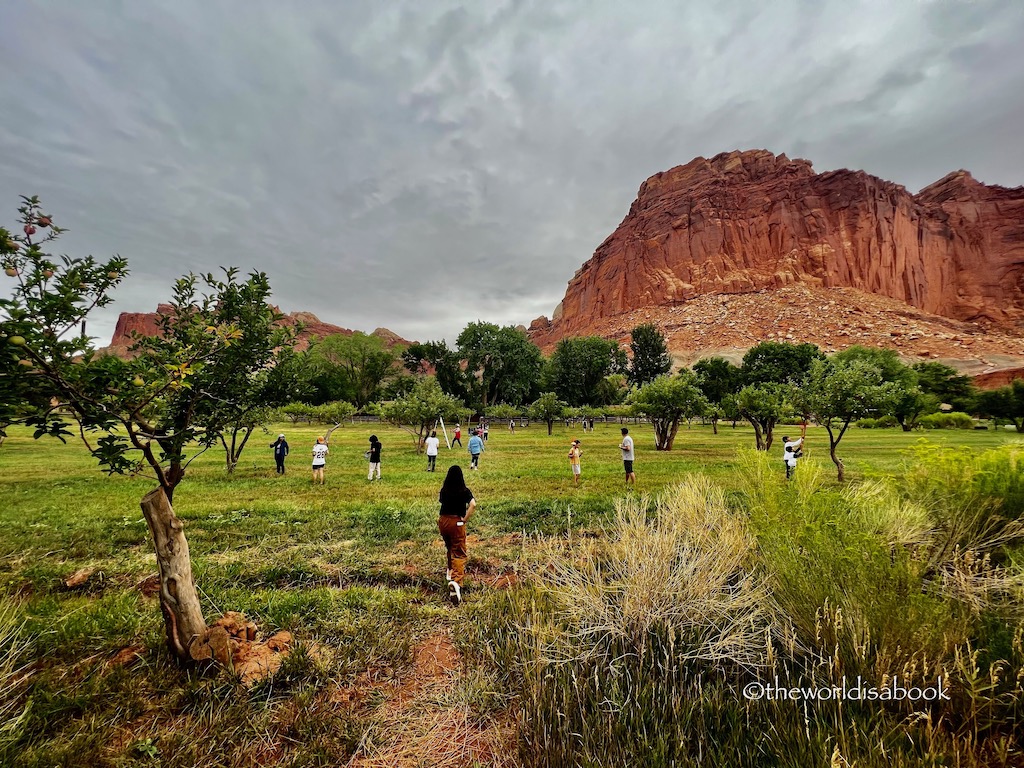
The Fruita settlement became a tight-knit community, and the residents lived a simple, self-sufficient lifestyle. In addition to farming, they also did cattle ranching and other activities to sustain themselves. At any given time, no more than 10 families lived in Fruita.
Over time, the Fruita settlement declined as younger generations sought opportunities elsewhere with the last resident moving away in 1969. However, the legacy of the Mormon settlers lives on in the park’s history and the preserved orchards that continue to bear fruit today.
Visiting Fruita in Capitol Reef National Park is like stepping back in time. The historic buildings, orchards, and the enduring spirit of the Mormon pioneers who carved out a life in this rugged landscape provide a unique glimpse into the park’s past.
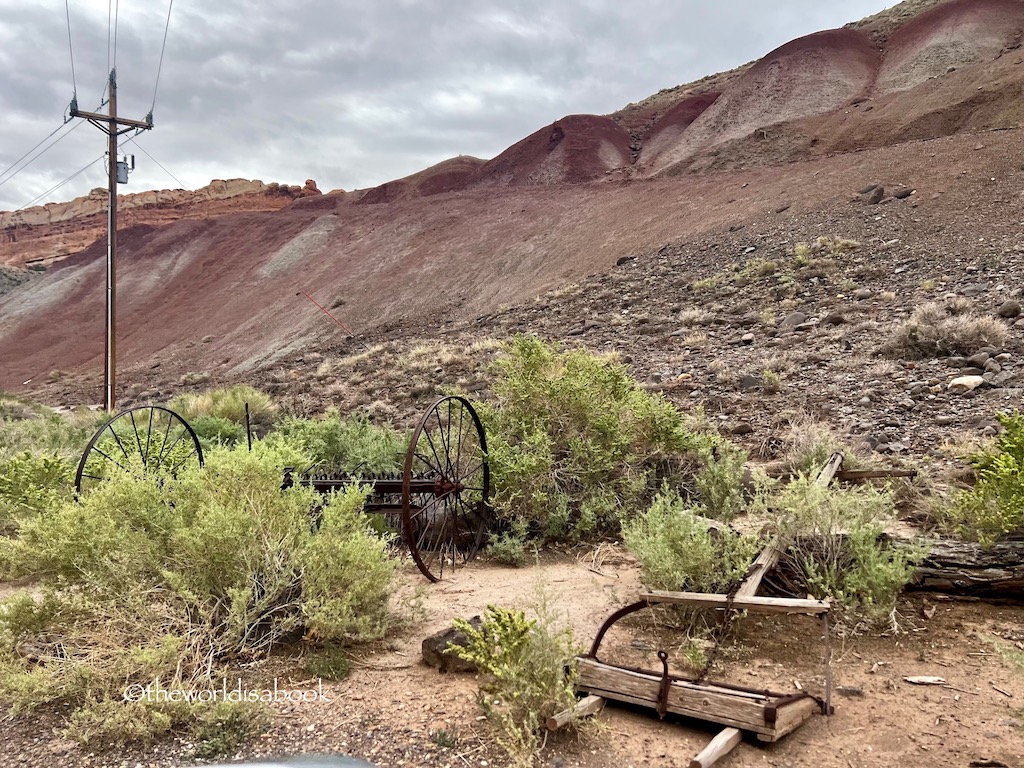
The Fruita Schoolhouse
This area is known as the Fruita rural Historic District and visitors can still visit some of the structures here.
The Fruita Schoolhouse, built in 1896, served as a center of education and community gatherings. This one-room schoolhouse was Fruita’s only public structure serving as their only school, community center and church meeting house.
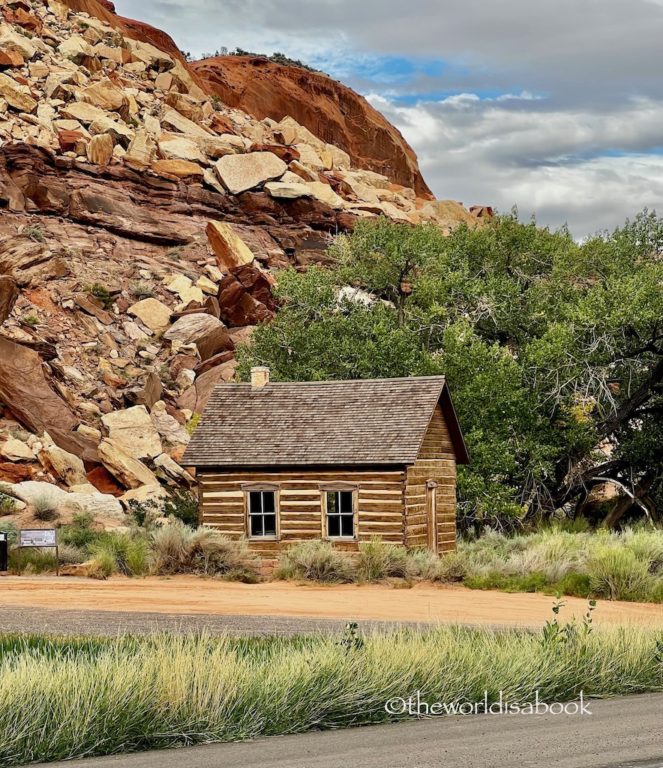
Class was last taught here in 1941 before the children were bussed to schools elsewhere. About 8 to 26 students across eight different grade levels were taught in this one room, heated by a woodstove and taught by one teacher.
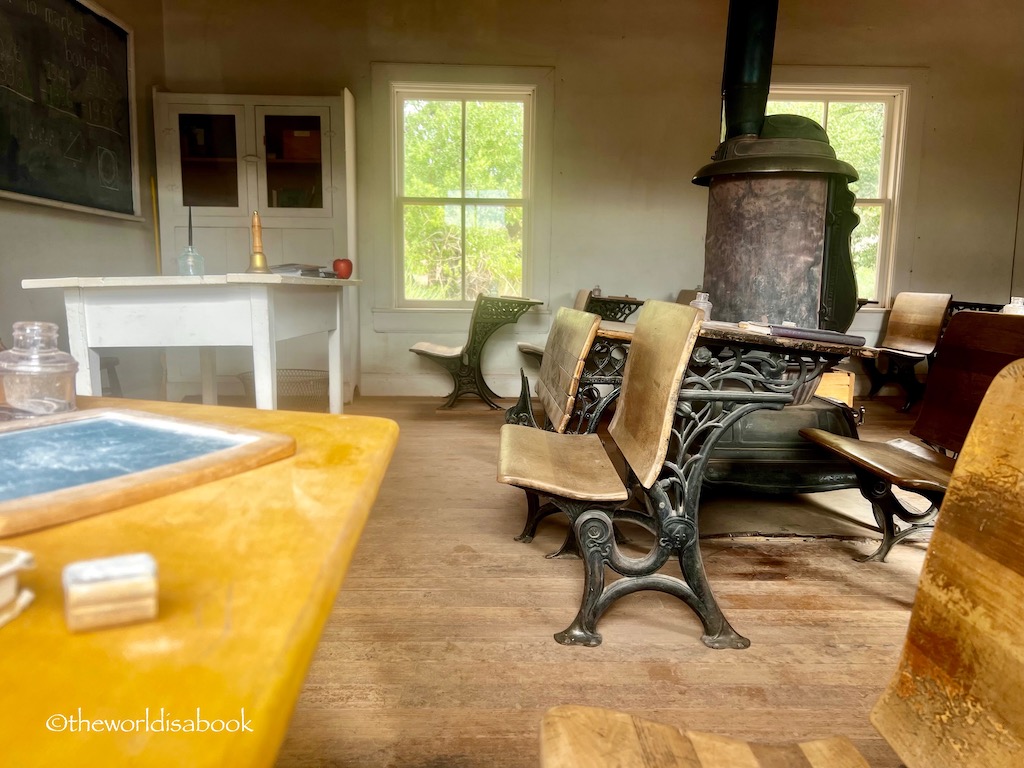
Pick Fruits
A unique feature of Capitol Reef is the historic Fruita Orchards. These were remnants of the Mormon settlement’s orchards that the National Park Service now maintains.
Visitors are allowed to pick fruits during the harvest season which is usually in late March to mid-October. These dates may vary so please check the park website or social media posts.
The Park rangers told us which orchards were open for fruit picking and gave us a handy map. There were also some signs along the scenic drive for open U-pick orchards. The various orchards have about 3,000 trees with many heirloom varieties.
The orchards have a variety of fruits that range from apples, cherries, peaches, pears and apricots. We picked apples at the Mott Orchard on our first day and peaches on our second day at the Krueger Orchard.
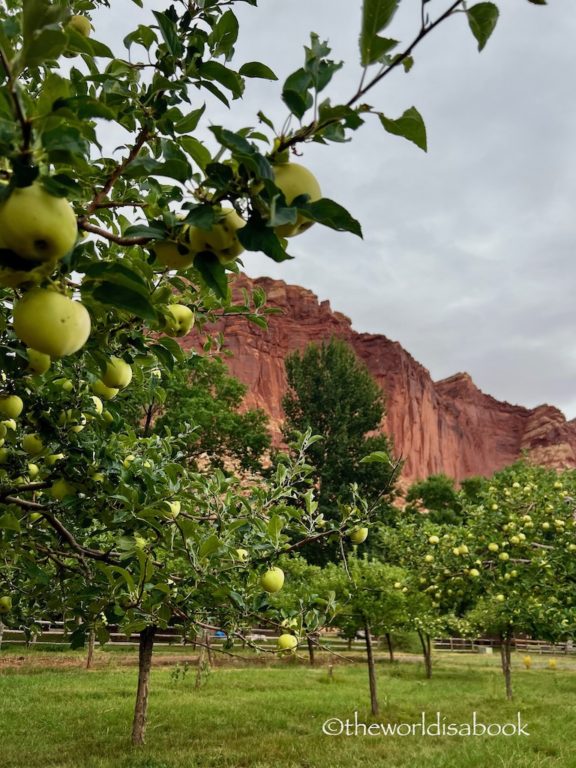
We’ve never picked fruits at any national park so it this was such a treat for us and we really enjoyed it. Fruits eaten in the orchards are free. Those taken from the orchards must be paid for using a self-pay station (an honor system) by the gates which had scales and plastic bags.
During our August visit, fruits were $2 per pound. We also saw fruit pickers and ladders to help pick fruits. Please don’t climb the trees and only pick ripe fruits.
We saw several families here having a wonderful time. It’s a great way to teach kids about farming while eating some healthy and delicious fruits.
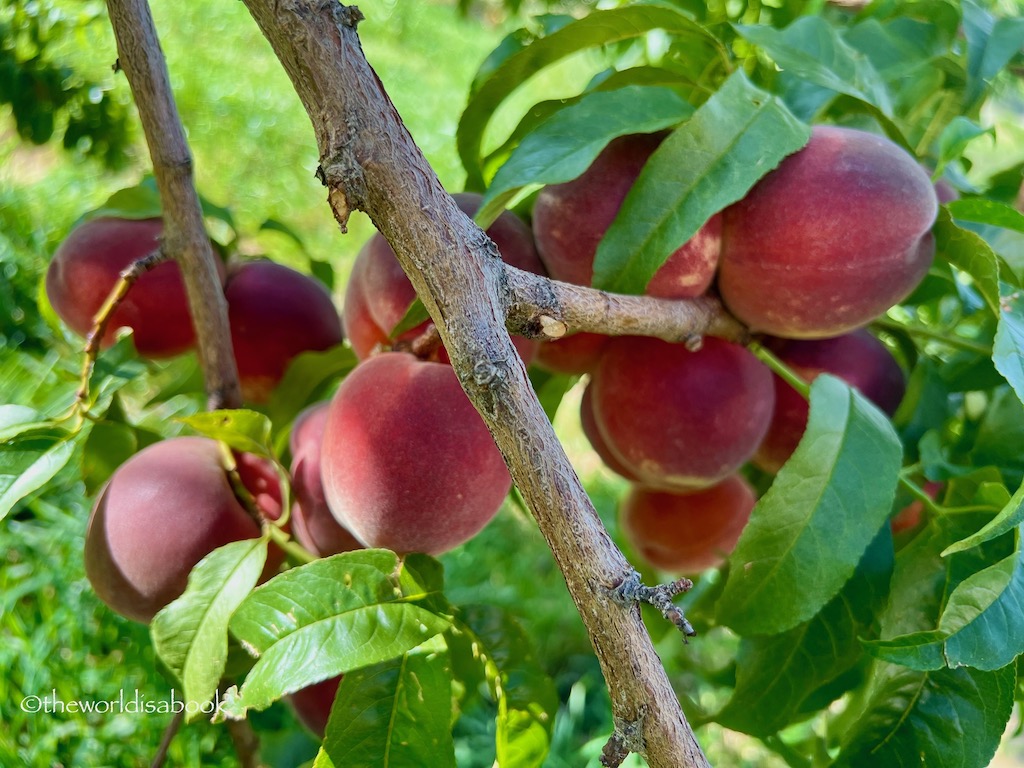
Eat some fruit pies
With the surrounding orchards, it was no surprise to find out the park actually has a store selling mouthwatering fruit pies. These pies are a connection to the park’s history and a delightful way to sample the flavors of the nearby orchards.
The resourceful settlers began making pies as a way to preserve the harvest and create delicious treats using the orchard’s fruits. The pioneer women of Fruita developed their own recipes, and over time, these pies became a cherished part of their culinary heritage.
The best place to savor these fruit pies is at the Gifford House. This is a historic building in Fruita that now serves as a bakery, and gift shop with plenty of handcrafted items and souvenirs. It also has a small museum with exhibits on pioneer history.
Here, you can indulge in freshly baked pies made from the same fruit trees that the pioneers planted over a century ago.
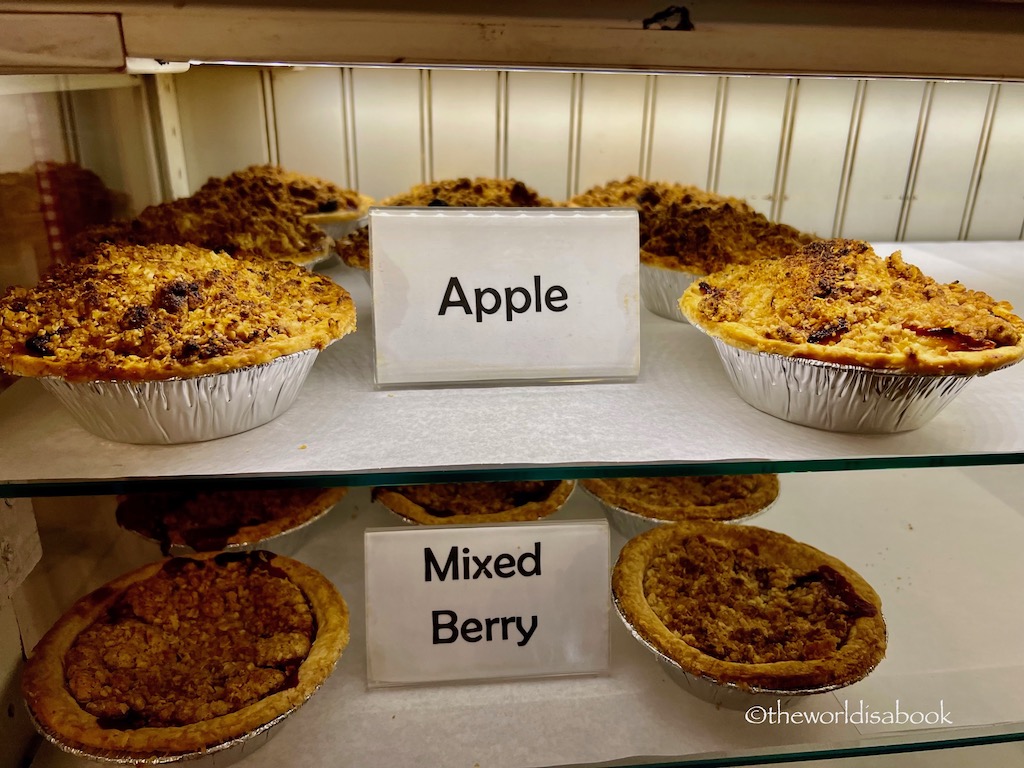
The Gifford House offers a variety of fruit pies depending on the seasonal availability of fruits. Each pie is handmade using time-honored recipes that pay homage to the settlers who started this delicious tradition.
Try to get there early since they often run out. The Gifford House closes at 4 PM. We were here around 2 PM and luckily, they still had some pies. Each mini pie costs $8. We got the mixed berry which was enough for the three of us. And it was delicious!
The Gifford House has a picnic area with plenty of seating outside along the river. We loved the sound of the river and being surrounded by the red rock cliffs. We even had a deer visit us while we were here.
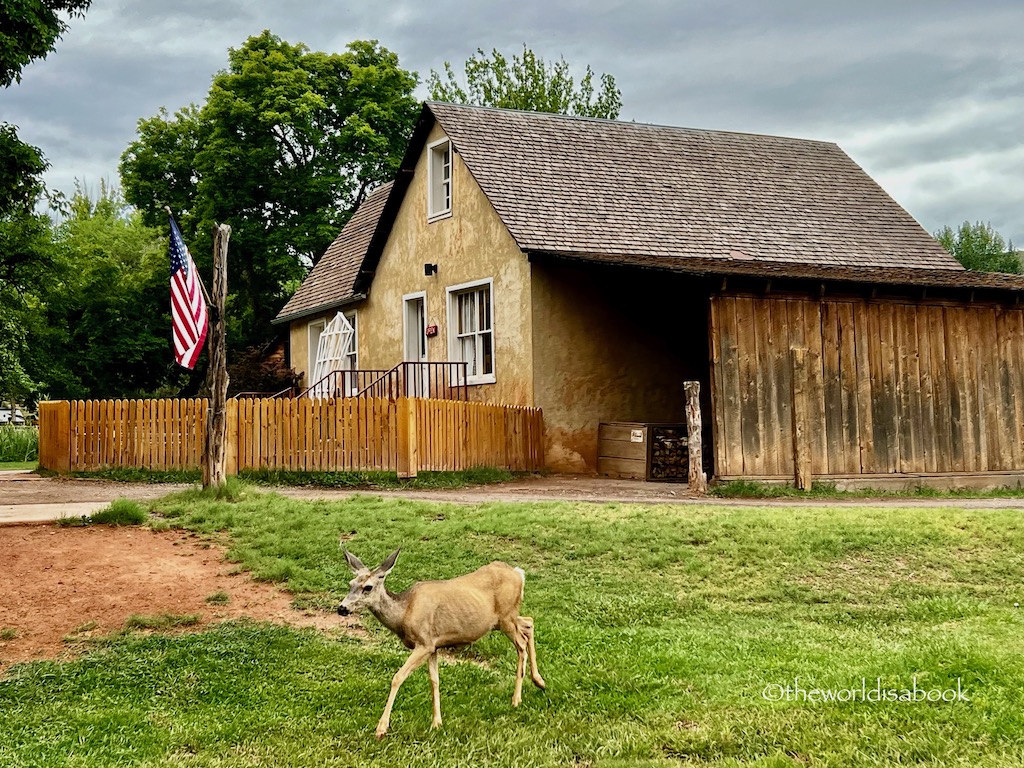
Do the Scenic Drive
If you are short on time, this is the drive to do. See the park’s incredible landscapes through the paved, 8-mile Scenic Drive that winds through the park’s heart.
Keep an eye out for the famous Waterpocket Fold, a massive wrinkle in the Earth’s crust that defines Capitol Reef’s rugged terrain. There are several stops and lookout points along the way to admire the views and marvel at the geologic features. Allocate at least two hours for this roundtrip drive.
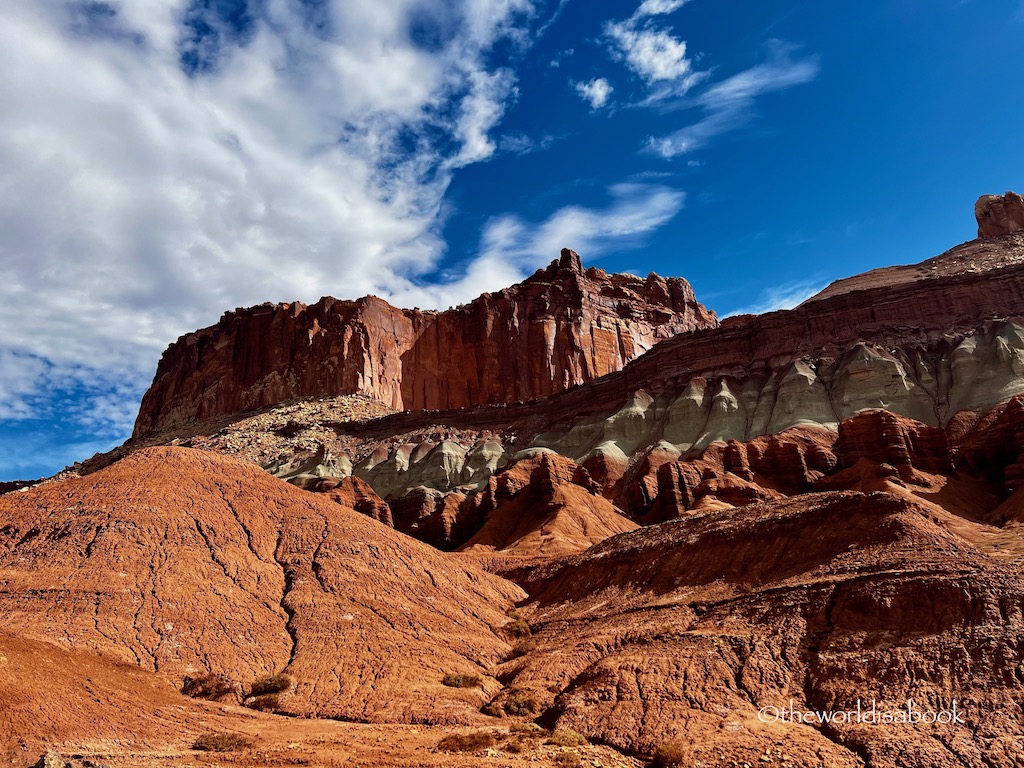
Stop at the Lookouts
There are several lookout and panoramic points along the scenic drive and before the visitor’s center area. Don’t miss these as they give an amazing overview of certain parts of the incredible landscapes. Panorama Point and Goosenecks Overlook are two popular areas to stop.
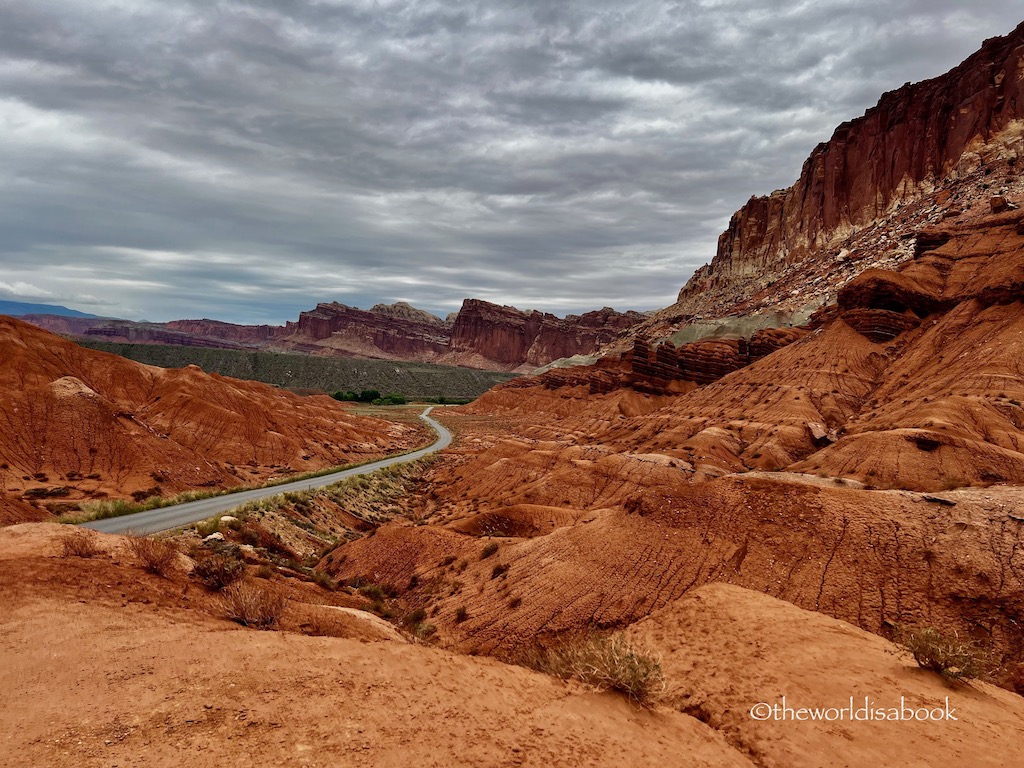
Hike the Trails
Capitol Reef offers an array of hiking trails, catering to all levels of fitness and experience. These trails offer unique opportunities to immerse yourself in the park’s geological wonders while providing a memorable hiking adventure.
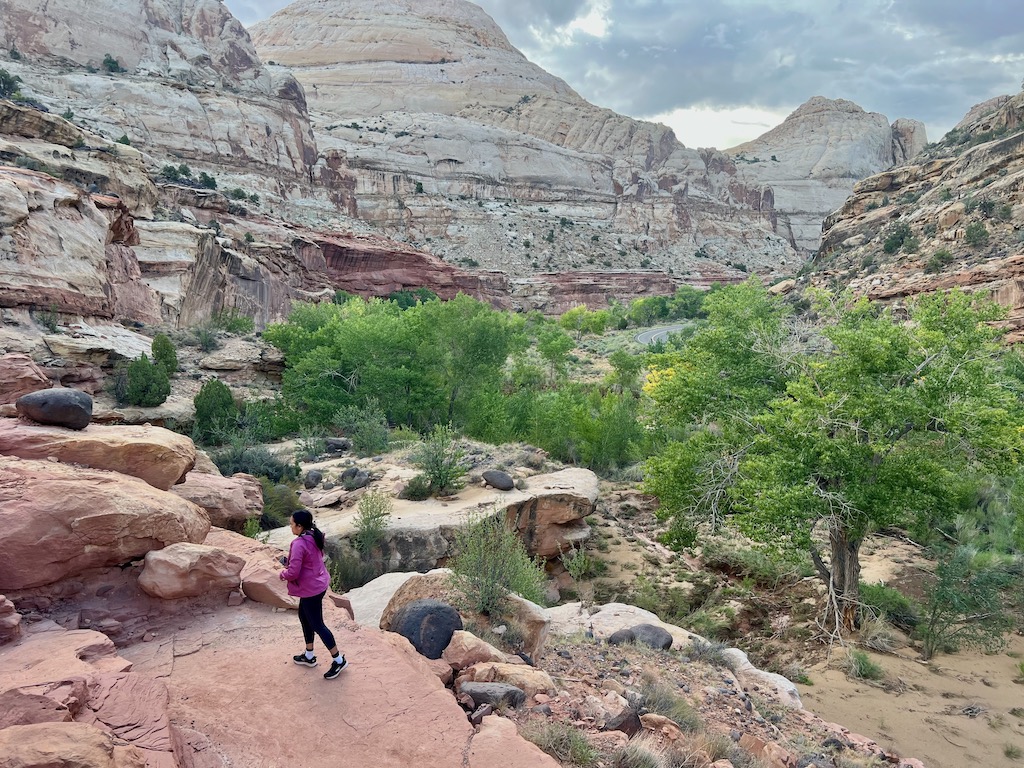
I really wish we had more time during our visit to do more of these trails. It’s just another reason to return. Here are some of the park’s popular trails:
Easy Hikes
Sunset Point Trail – This is an easy 0.4 mi (0.6 m) one way trail. It has panorama views and great for sunset and sunrise viewings hence its name.
Capitol Gorge Trail
This trail is about 2 miles (3.2 kilometers) round trip. It’s a relatively easy hike with minimal elevation gain. You can access this trail by going all the way to the end of the Scenic Drive to Capitol Gorge Road.
It’s a 2.4 mile unpaved road that leads to a parking area. Unfortunately, the park closed this road during our visit due to rain from the previous days.
Capitol Gorge has some petroglyphs but the highlight is the Pioneer Register. This is a collection of inscriptions on the rocks left by early travelers in the late 19th and early 20th centuries. It’s like reading a historical guestbook of the canyon.
Deeper into the trail, the canyon walls gradually narrow. Keep an eye out for “The Tanks,” natural basins in the rock that collect water after rainfall.
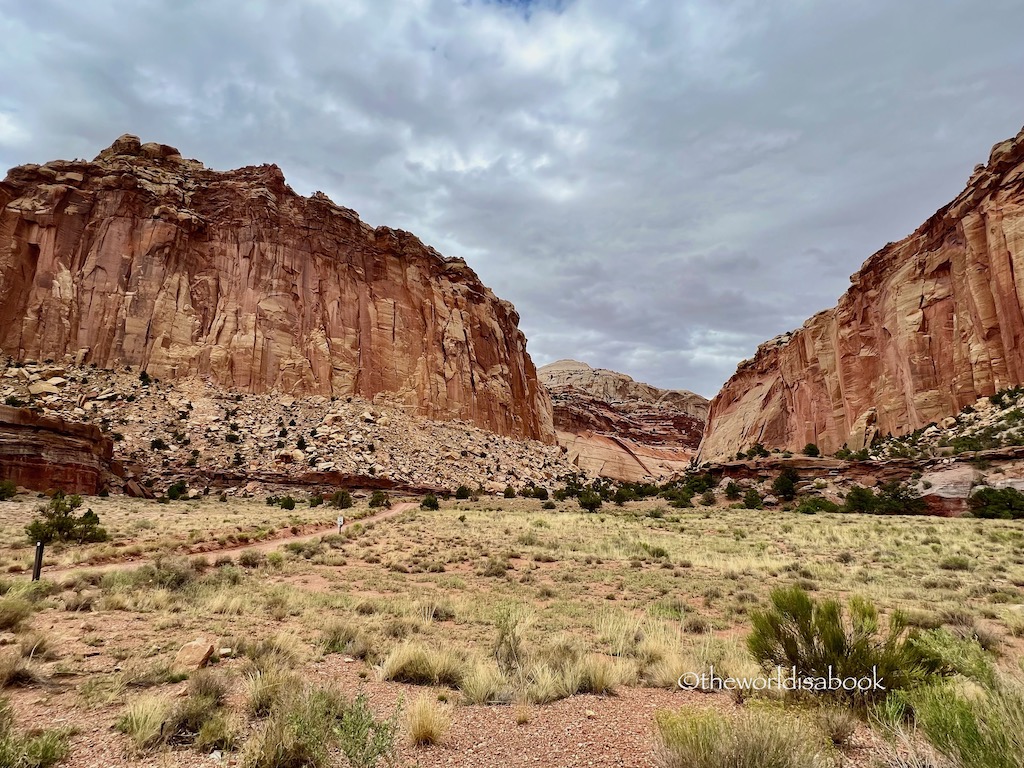
Grand Wash Trail
This trail is about 2.2 miles (3.6 km) one way with minimal elevation change. It is a family-friendly option, featuring towering red rock walls and easy terrain.
There are two ways to access this trail. One is through the Grand Wash Road from the Scenic Drive. This is a drive of about 1.3 miles into a parking lot which is also the same one for the Cassidy Arch Trail. Unfortunately, Grand Wash Road was also closed when we visited.
The other entrance to the trail is at State Route 24. There was a parking lot too. We entered the trail here and walked for about 15 minutes.
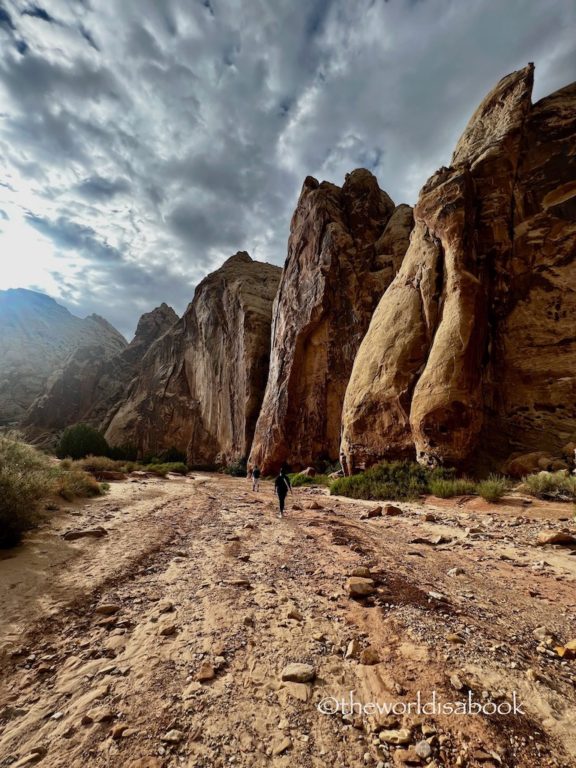
It was getting late and we were the only ones on this trail and we did’t feel comfortable walking further. The towering canyons here were incredible.
The highlight of the Grand Wash Trail is undoubtedly the stunning slot canyon called The Narrows. As you venture deeper into the canyon, you’ll be surrounded by towering sandstone walls that narrow in places to just a few feet wide. We saw a glimpse of these sandstone walls during our hike.
Be aware of the risk of flash floods in narrow canyons. Check the weather forecast and avoid hiking if rain is expected, as flash floods can occur suddenly and are extremely dangerous.
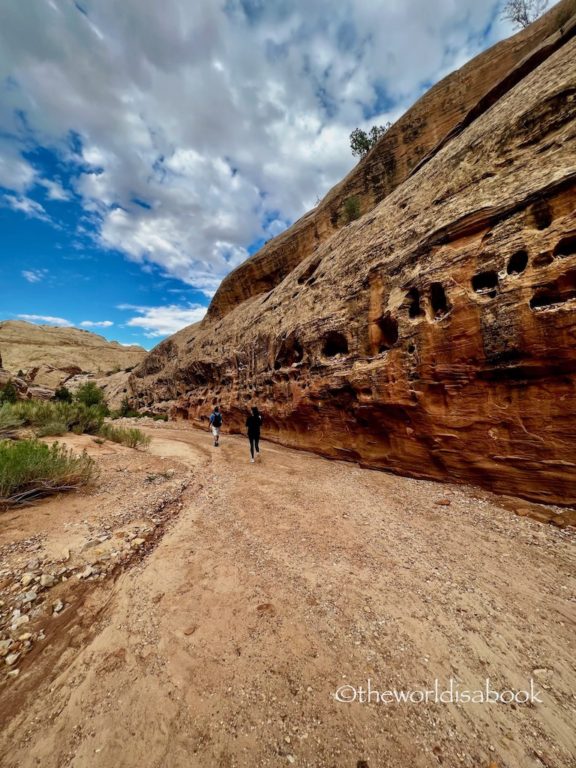
Moderate Hikes
Hickman Bridge Trail – According the the park ranger, the Hickman Bridge Trail is the most popular hike in the park. We saved this hike for early in the morning (around 8 AM) on our second day.
The round-trip hike to Hickman Bridge is approximately 1.8 miles (2.9 kilometers) with 400 ft elevation change, making it a manageable and relatively short hike. Plan for about 1-2 hours to complete the hike, depending on your pace and how much time you spend exploring or stop to take pictures (like us).
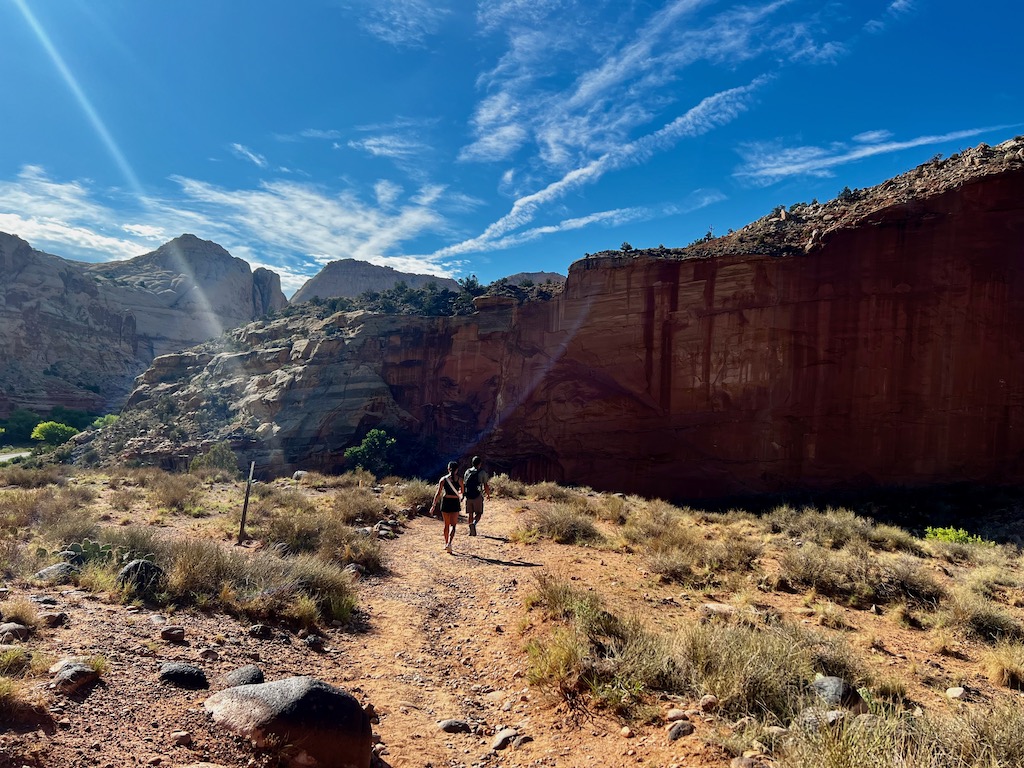
Most of the first part of of this trail was all uphill. Beautiful red rock formations that define Capitol Reef surrounded us and the trail led us through a picturesque canyon
The highlight of the trail was the impressive Hickman Natural Bridge, which is a massive sandstone arch spanning 133 feet (40.5 meters). It’s a sight to behold, especially when you consider the natural forces that carved this stunning feature over countless millennia.
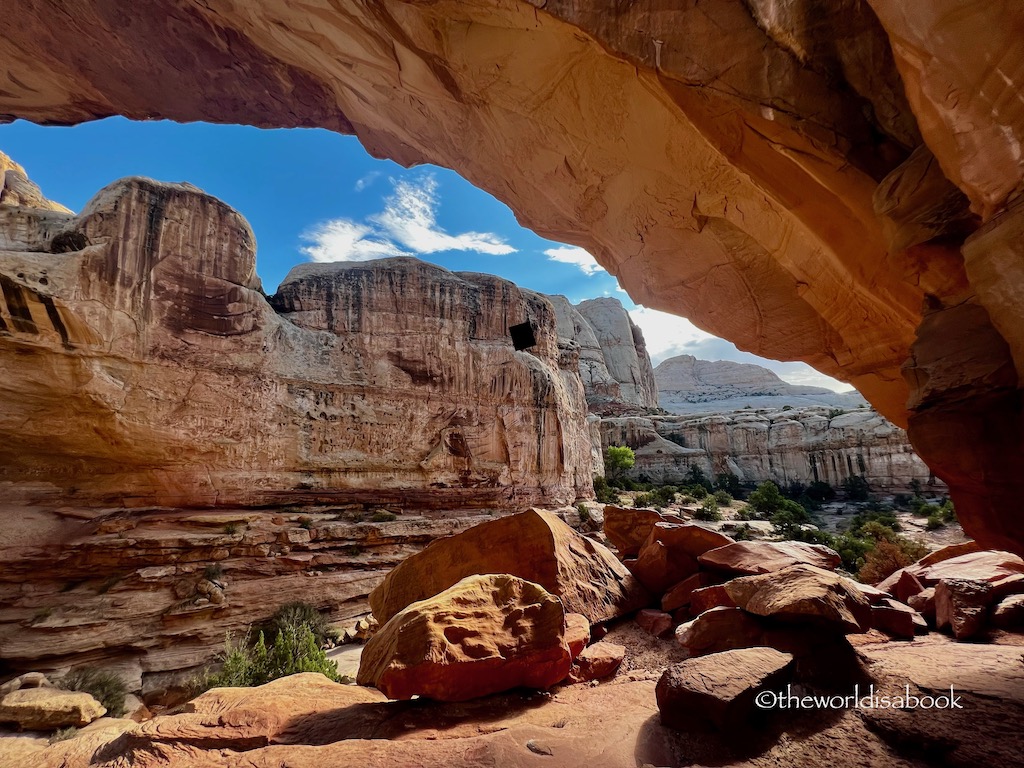
We loved taking pictures of this bridge from all angles. The bridge is named after Joseph S. Hickman, a local school teacher who played a role in popularizing Capitol Reef as a national monument.
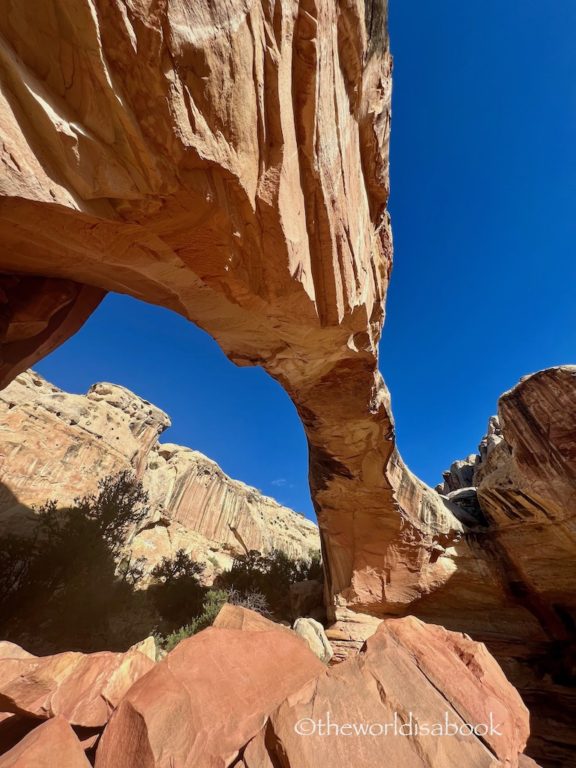
The Fremont River Trail is 2 miles round trip which is an easy stroll along the river. There is an 480 ft elevation change and a steep climb to see some panoramic views.
Strenuous/Challenging hikes
Cassidy Arch Trail is a 1.7 miles (2.8km) one way trail with 670 ft elevation change. The highlights are a natural arch, slick rock and canyon views. They named it after the infamous outlaw Butch Cassidy who supposedly hid out here.
Chimney Rock Loop is (3.6 mil(5.9 km) roundtrip with 590 ft elevation gain. It has incredible panoramic views of the Waterpocket fold cliffs and good for sunset viewing.
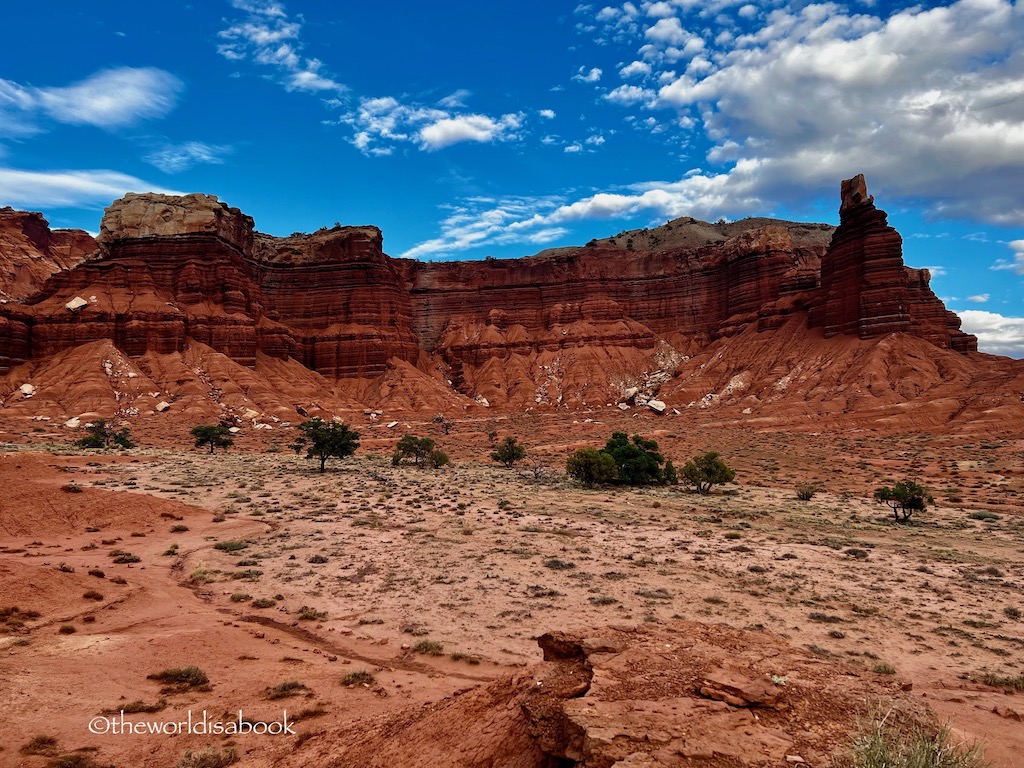
Look for Petroglyphs and Pictographs
Capitol Reef National Park holds a treasure trove of cultural and historical significance in the form of petroglyphs and pictographs. These ancient rock art creations offer a glimpse into the lives and beliefs of the people who once lived here.
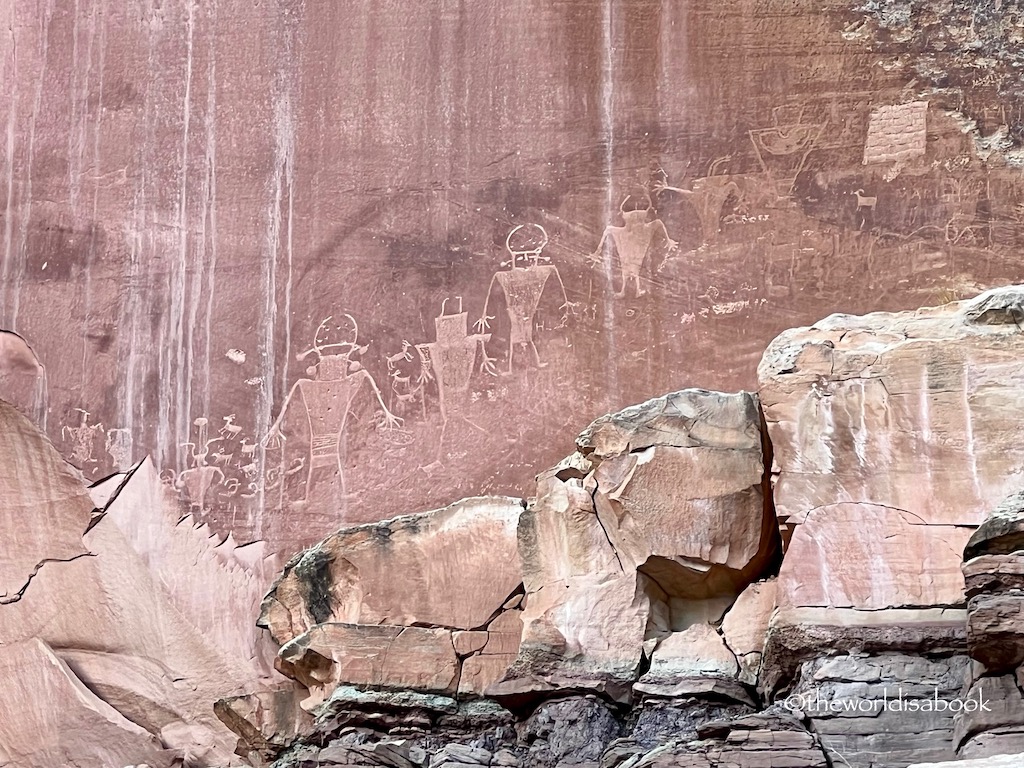
There is a difference in these rock arts:
Petroglyphs are rock carvings created by chipping or pecking away at the surface layer of the rock to reveal a design or image. They are typically lighter in color than the surrounding rock and are the most common form of rock art found in Capitol Reef.
Pictographs are paintings or drawings made by applying pigments to the rock’s surface. They can be found in various colors, depending on the pigments used, and are less common in Capitol Reef compared to the petroglyphs.
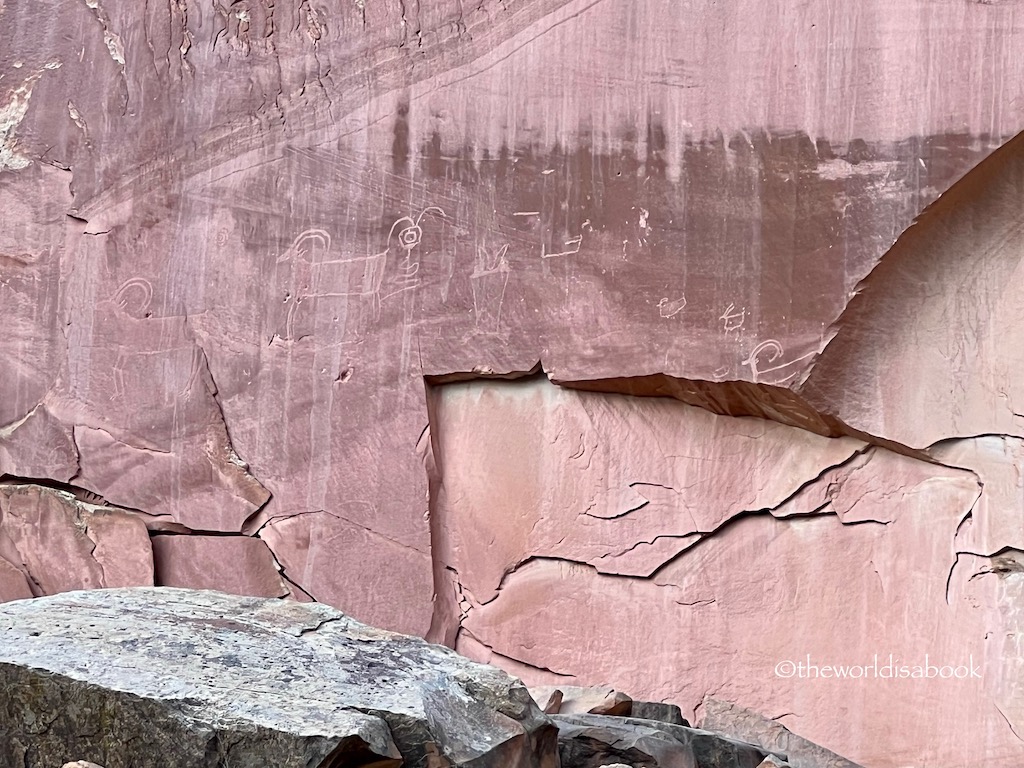
The creators of these ancient artworks are believed to be the indigenous peoples who once roamed the region. Historians believe that from 600 to 1300 C.E, the native people of the Fremont Culture contributed to the rock art.
Where to Find the Petroglyphs and Pictographs
The Petroglyph Panel: The most popular and easily accessible location to view petroglyphs in Capitol Reef is the Fremont Petroglyph Panels. Located along the State Route 24 (about 1.1 miles from the Visitors center), this site features a mesmerizing collection of petroglyphs etched into the red rock.
The designs include human figures, animals, abstract shapes, and more, providing a window into the cultural and spiritual beliefs of the ancient inhabitants. There is a small platform with telescopes to see them. Walk further along the wooden platform to see others carved near the end.
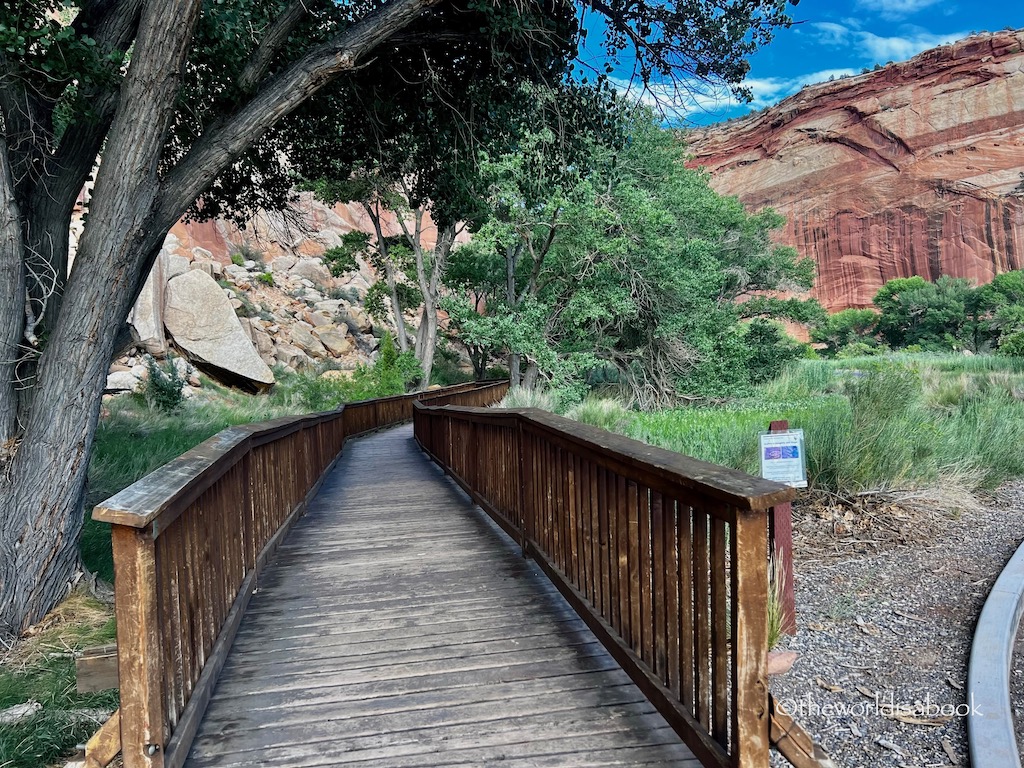
Go Stargazing
Capitol Reef is designated as an International Dark Sky Park, making it a prime spot for stargazing. Whether you’re an amateur astronomer or just want to see the wonders of the night sky, be sure to stay up and enjoy the celestial show.
The park offers stargazing programs and opportunities for visitors. Panorama Point, Danish Hill and Slickrock Divide (both on the Scenic Drive) and the Fruita Campground Amphitheater parking area are some of the best spots in the park for stargazing. The park is open 24 hours.
Check the park’s activities calendar for ranger programs. During our visit and it looks like for subsequent months, there was a Night Sky & Telescopes event nightly. The program runs for 1.75 hour, starts at 9PM and meets at the amphitheater parking lot near Loop C of the Fruita Campground.
Unfortunately, it was very cloudy during our visit so we didn’t see any stars. I hope that you can take advantage of this program and have clearer skies during your visit.
Go Horseback Riding
if you’re looking for a different perspective of Capitol Reef National Park’s stunning landscapes, horseback riding offers a unique way to explore the rugged terrain.
Riding on horseback allows you to take in the park’s sweeping vistas at a leisurely pace. Meander through the park’s canyons and backcountry, red rock formations, and open desert expanses, all while enjoying unobstructed views.
To make the most of your experience and ensure safety, consider joining a guided horseback riding tour. It is suitable for riders of all skill levels and can be a great family activity.
We have enjoyed sightseeing via horse riding tours over the years. Check on the age restrictions and seasonal availability of tours though. Here are three companies offering horseback riding tours:
Wilderness Ridge Adventures – Minimum age is 8 years old; Tours are available mid-March through late-October. One and two hour trail rides are available.
BackCountry Outfitters – This company offers one and two hour trail rides plus half and full day tours. Minimum age is 6 years old.
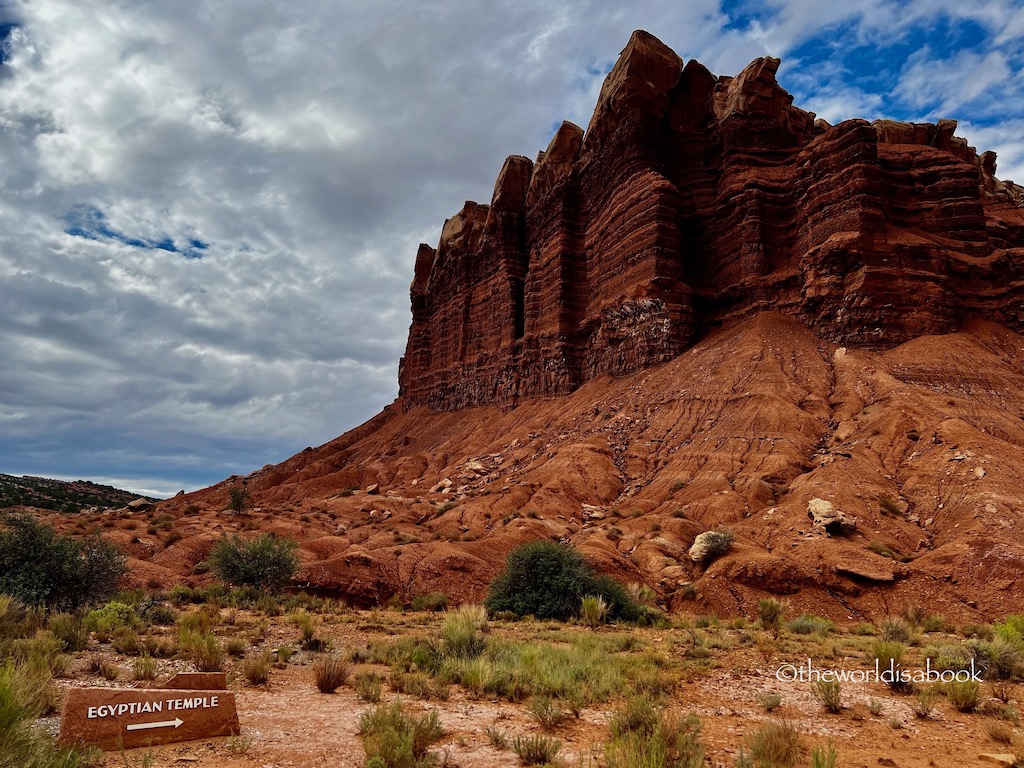
Do the Jeep Tours
Exploring Capitol Reef National Park from the comfort of a guided Jeep tour is an exceptional way to experience the park’s rugged beauty and uncover its hidden gems. These tours offer unique access to some of the park’s most remote and stunning locations.
Here are companies offering jeep tours:
Backcountry Safari – They offer several half-day tours covering various parts of the park. Tours run from April to October.
Capitol Reef Jeep Tours – They offer tours that range from 2-3 hours to full day ones to various points of Capitol Reef. There are also sunset and sunrise departure or overnight camping add-ons.
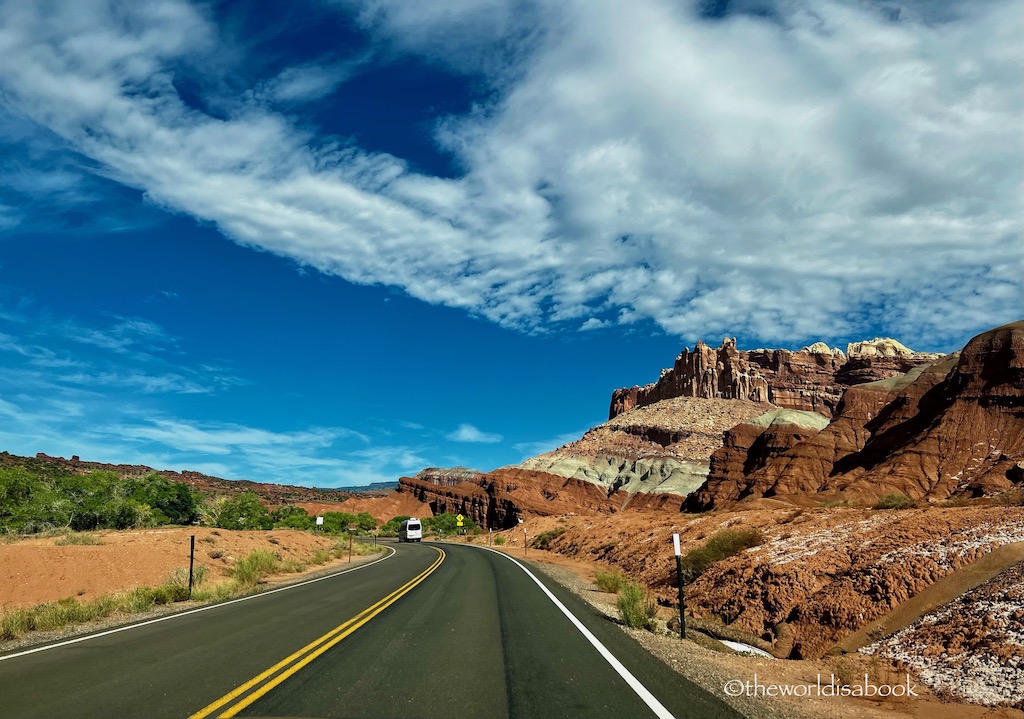
Tips for Visiting Capitol Reef National Park
- Weather Matters: Capitol Reef experiences extreme temperature fluctuations, so pack accordingly. Summers can be scorching, while winters can bring chilly temperatures and snow at higher elevations.
- Hydration is Key: The desert climate can be deceptively dry. Make sure you and your kids stay hydrated throughout your visit by carrying plenty of water.
- Respect the Environment: Stay on marked trails, and never disturb wildlife or vegetation. Leave no trace to help preserve this remarkable landscape.
- Trail Etiquette: As with all trails in the park, be sure to follow Leave No Trace principles, stay on designated paths, and refrain from climbing on or touching fragile rock formations.
- Check for Park Alerts: Before you go, check the park’s website for any alerts or closures. Verify cloures and alerts when you get to the visitors center. Conditions can change, so it’s essential to be informed. The park closes trails especially after heavy rains.
- Permits and Passes: Depending on your activities, you may need permits for camping or canyoneering. Be sure to check the park’s website for permit information and fees.
- Hiking conditions: The best times to hike the trail are during the spring and fall when the weather is milder. Summers can be scorching, so it’s essential to bring plenty of water and consider starting your hike early in the day. During winter, the trail may be icy or snowy, so check with the visitor center for trail conditions.
- How long to spend in the park? If you’re driving from Salt Lake City, start early and you’ll get here around lunchtime. We had about a day and a half here which allowed us to see many of the main attractions, hike and do the Scenic Drive. I would allocate at least two days so you can do more of the other tails.
Where to Stay in Capitol Reef National Park
If you prefer a more rustic experience, check out the park’s campgrounds, such as Fruita Campground or Cathedral Valley Campground. The Fruita camping site has a nominal fee with 71 spaces (eight people limit per site) but has a wonderful location.
While camping is a great option for those who want to immerse themselves fully in the park’s natural beauty, there are also some fantastic lodging options nearby. The town of Torrey, just outside the park, offers various accommodations, from cozy cabins to charming bed-and-breakfasts.
We stayed at Red Sands Hotel & Spa for one night. It was spacious, clean, had a wonderful pool and outdoor area. There was also a restaurant on-site.
Torrey also had several food trucks and the Chuckwagon General Store and Deli/Bakery was our go-to place for essentials and breakfast. Check out the highly-rated food truck, Capitol Burger. We had their burgers for dinner and they were delicious.
Go Visit!
Capitol Reef National Park offers so much for travelers, hikers and families. From its unique geological formations to its rich history and vibrant orchards, this park has become one of my favorites.
So, grab your hiking boots, pack up the family, and get ready to experience the wonders of Utah’s hidden gem! Pictures and videos cannot truly capture the beautiful landscapes. We can’t wait to return to this park.
Check out these other tours in Capitol Reef National Park
Pin it for later!
